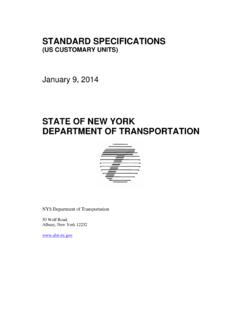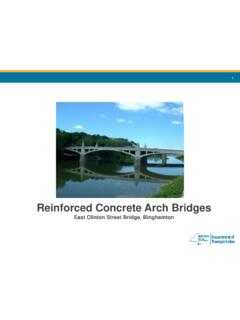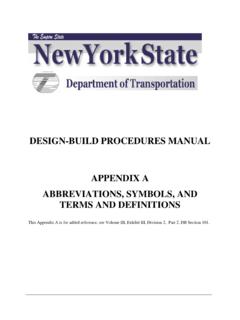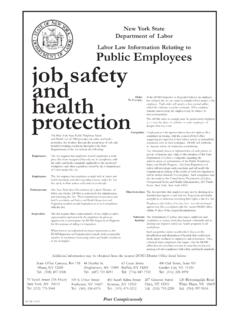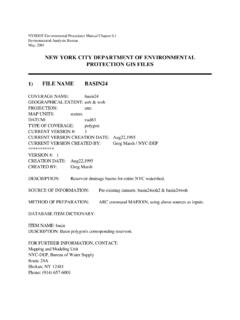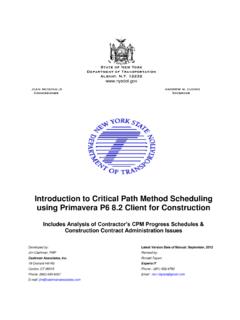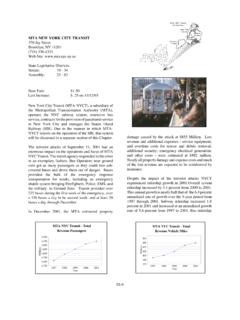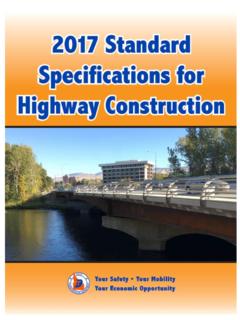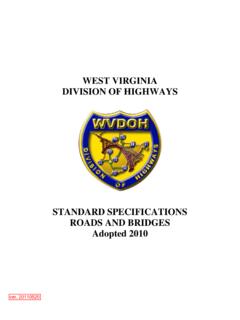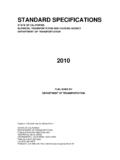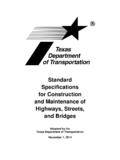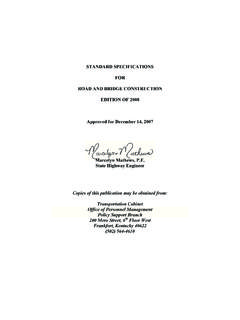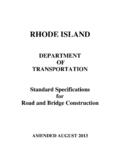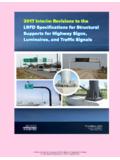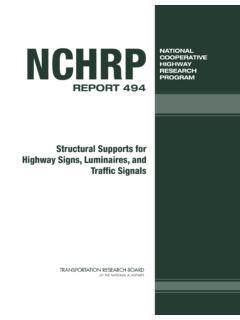Transcription of STANDARD DESIGN SPECIFICATIONS FOR …
1 NEW YORK STATE DEPARTMENT OF TRANSPORTATION STANDARD DESIGN SPECIFICATIONS FOR structural SUPPORTS FOR OVERHEAD SIGN STRUCTURES, 2007 NYSDOT OVERHEAD SIGN STRUCTURE (OSS) BLUE PAGES The following is a list of the articles of AASHTO s STANDARD SPECIFICATIONS for structural Supports for highway Signs, Luminaires and Traffic Signals, 4th Edition, 2001, with the 2002, 2003, and 2006 Interim SPECIFICATIONS (called in this document AASHTO Sign Supports) revised as a Blue Page change and incorporated in this document, the NYSDOT STANDARD DESIGN SPECIFICATIONS for structural Supports for Overhead Sign Structures, 2007. Included with each change is a commentary intended to explain some of the background issues driving the change.
2 ARTICLE NOTATIONS GROUP LOAD COMBINATIONS ICE AND THERMAL FORCES WIND LOAD GALVANIC CORROSION SCOPE APPLICABLE STRUCTURE TYPES DESIGN CRITERIA FATIGUE IMPORTANCE FACTORS FATIGUE DESIGN LOADS NATURAL WIND GUST TRUCK-INDUCED GUST TABLE 11-2 FATIGUE DETAILS FIGURE 11-1 (b) ILLUSTRATIVE EXAMPLES GEOTECHNICAL DESIGN APPENDIX C, WIND PRESSURE FORMULA NYSDOT 02/07 NYSDOT 04/03 This page intentionally left blankNYSDOT 04 , after rs:T = Thermal Force, as defined in Article ofNYSDOT STANDARD SPECIFICATIONS for HighwayBridges (2002).To reflect the addition of the force dueto temperature change in Table 04 LOAD COMBINATIONSD elete Table 3-1 Group Load Combinationsand replace with the following:AASHTO Sign Supports does notinclude provision for thermal forces.
3 TheDepartment has determined that stresses dueto temperature changes can be significant andtherefore should be accounted for in thedesign. Two new Group Loads, IIB and IIChave been introduced to reflect the thermalforce 3-1 Group Load Combinations (see Note 4)Group LoadLoad CombinationPercent of AllowableStress(see Note 1)IDL100 IIADL + W133 IIBDL + T125 IICDL + W + T140 IIIDL + Ice + (see Note 2)133 IVFatigue(see Note 3) given percentages of allowable stress are applicable for the allowable stress designmethod. No load reduction factors shall be applied in conjunction with these increasedallowable shall be computed on the basis of the wind pressure equation.
4 A minimum value of1200 Pa (25 psf) shall be used for W in Group Load Section 11 for fatigue loads and stress range Article regarding application of live 04 LOADS AND THERMAL FORCESD elete the text of Article and replace withthe Ice Load on Curved Elements andFlat Panel SignsIce load shall be a load of 145 Pa( psf) applied on the surfaces of the OSSelements and on one face of the sign panelsattached to the Ice Load on Flat Horizontal SurfacesIce load shall be a load of 970 Pa(20 psf) applied to exposed flat horizontal(<10% slope) surface Thermal ForcesThermal forces shall be applied to signstructures in order to evaluate the effects ofsuch loads on the posts and span trusses.
5 Thetemperature rise and fall shall be in accordancewith the NYSDOT STANDARD SPECIFICATIONS forHighway Bridges (2002), Article , for metalstructures in a cold climate. Erectiontemperature shall be assumed to be 20degrees Celsius, unless more specificinformation is available for the AASHTO ice load is a nominal 15mm thick layer of ice on the surface area ofstructural elements and one face of panelsigns. This load is not conservative whenapplied to horizontal elements in New YorkState, which are likely to see a much greaterice and snow build-up in many of the State'sregions. However, due to the increasedallowable stress for Group Load III, this loadrarely governs the DESIGN of the certain special circumstances,member sizes may be controlled by thermalloads, particularly for long span sign structureswith stiff post assemblies.
6 The thermalloadings are not expected to govern OSSdesign under normal 04 LOADD elete the text of Article and replace withthe following: DESIGN wind pressures shall becomputed in accordance with the alternatemethod described in AASHTO Appendix C,with the exception that the .Based on the experience of 30 years ofsign structures in place across Long Island, thepressures resulting from Equation 3-1 areoverstated. The Height and Exposure Factor,Kz, is used because a more detailedbreakdown is available for Kz than for 04 Galvanic Corrosion (Contact with Dissimilar Metals)Delete the text of Paragraph a) and replacewith the following.
7 A)Steel surfaces to be placed in contactwith aluminum shall be isolated fromthe aluminum by means of a RubberImpregnated Random Fiber Pad, asdescribed in the current version of theNew York State StandardSpecifications, under ensure the long term performanceand safety it is necessary to isolate galvanizedsteel from 04/03 This page intentionally left blankNYSDOT 04/03 This page intentionally left blankNYSDOT 04 the word cantilevered from the secondline of this is an issue in both span andcantilever overhead sign structures. At thetime of this writing, fatigue in cantileverstructures is recognized as more critical andsignificant laboratory testing has beenperformed, however little fatigue testing hasbeen performed on span structures.
8 Until moredefinitive testing has been performed,NYSDOT will apply fatigue criteria to both spanand cantilever 04 STRUCTURE TYPESR evise the first sentence to read: DESIGN for fatigue shall be required forthe following types of structures:Revise Article a) to read:overhead span and cantilever sign structures,As indicated in Article , NYSDOT considers fatigue an issue for both span andcantilever structures and requires that bothtypes of structures be designed for 04 CRITERIAD elete the word cantilevered from the firstand last sentences of this span and cantilever signstructures shall be designed for the infinite 04/03 This page intentionally left blankNYSDOT 04 IMPORTANCE FACTORSAdd the following paragraph after the paragraphshown in Article.
9 The importance factor, IF, for all OSSshall be DESIGN loads proposed to preventfatigue damage are applicable to all structuressubject to wind loads. NYSDOT considers allOSS to be critical, in that a failure in any suchstructure can have serious 04 DESIGN LOADSD elete the word cantilevered from the fourthline of the first considers that both span andcantilever structures should be designed fortwo of the fatigue DESIGN loads, Natural WindGust and Truck-Induced Gust. In concurrencewith AASHTO, Galloping is only applicable tocantilever structures and Vortex Shedding isonly applicable to nontapered 04/03 This page intentionally left blankNYSDOT 04 Natural Wind GustDelete the word cantilevered from the applies natural wind gustloads to both span and cantilever OSS, sincesignificant laboratory testing of span signstructures for such fatigue loadings has notbeen 04 Truck-Induced GustAdd the following before the first paragraph:Span and cantilever OSS shall bedesigned to resist an equivalent static truckgust pressure range of.
10 PTG = 525Cd (Pa) [or 11Cd (psf)] Delete the words Overhead sign and from thefirst the word cantilevered from the fifthline of the paragraph beginning where Cd Since the research on truck gust loadsis limited and based on minimal data, NYSDOT applies a reduced truck-induced gust load, butapplies the load to both span and cantileveroverhead sign 04/03 SPECIFICATIONSCOMMENTARYT able Details of CantileverSupport StructuresModify the title of the table to read:Table DetailsNYSDOT 04/03 SPECIFICATIONSCOMMENTARYT able 11-2 Delete Detail 19, (on Page 11-15) and replacewith the information indicated below:Definition of the fatigue stress categoryfor the fillet-welded gusset plate to tubularmember was not clearly identified in Table T-, Y-,and K-tube-to-tube,angle-to-tube, orplate-to-tubeconnections(Seenotes aand b)Gusset plate to tubularmain members(see note a).
